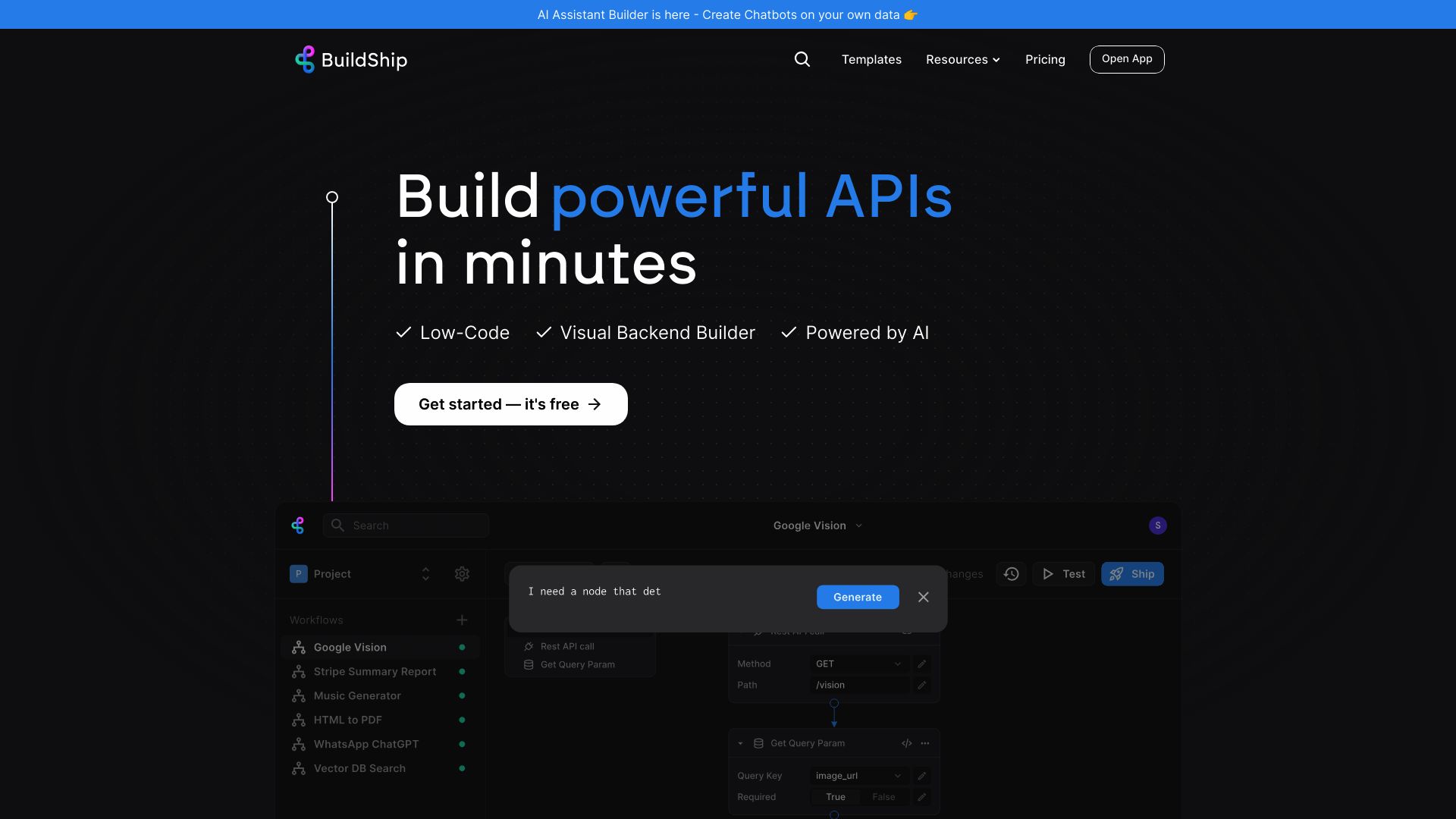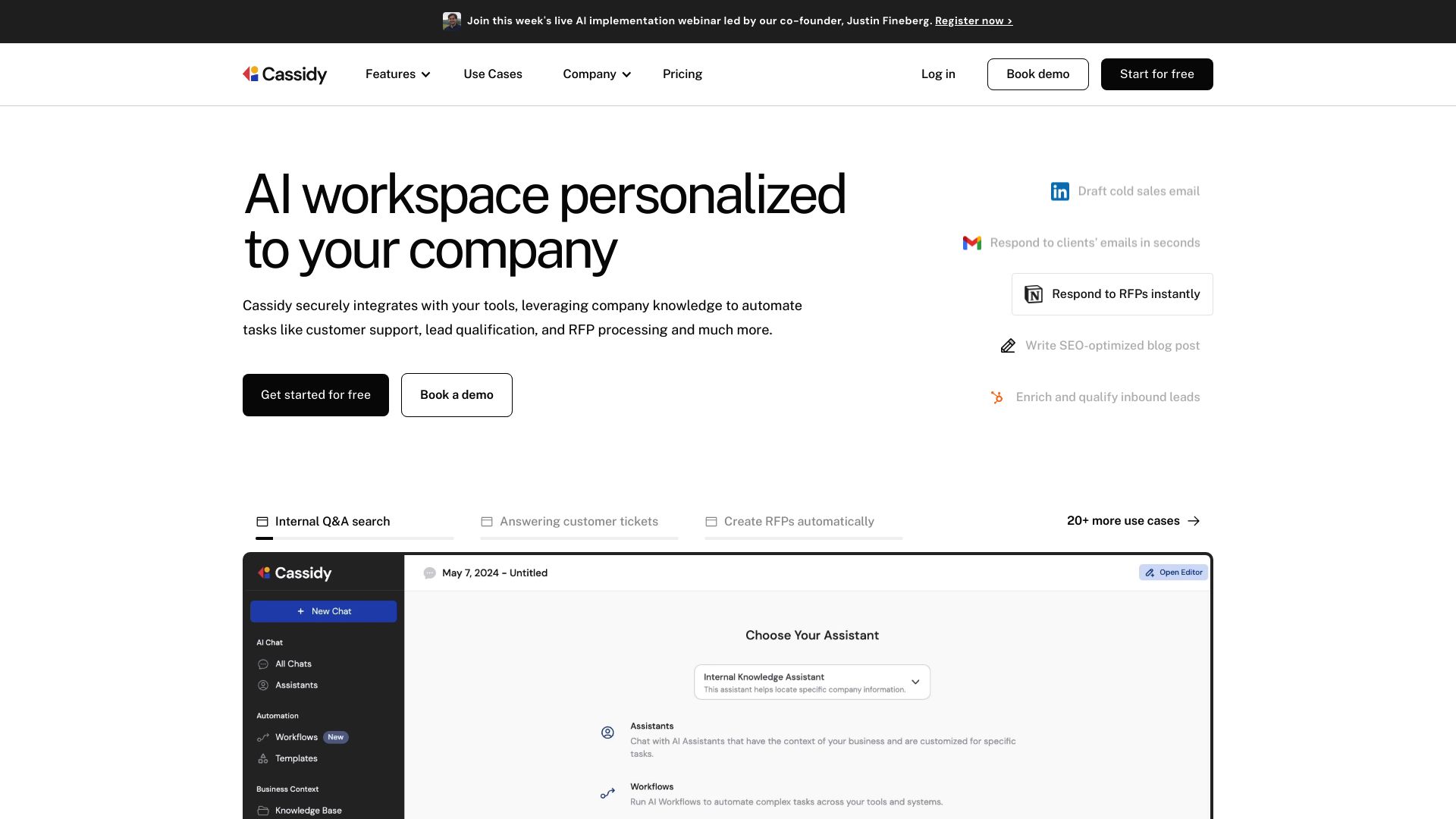BuildShip vs. Cassidy: AI Workflow Automation Showdown
AI platforms revolutionize backend development and business automation, but choosing the right solution challenges even seasoned professionals. This comparison delves into BuildShip’s visual workflow builder for backend systems, Cassidy’s customizable AI automations for business processes, and SmythOS’s comprehensive AI agent ecosystem.
We examine each platform’s strengths in no-code development, AI integration, and deployment options. Whether you’re a developer seeking efficient API creation, a business leader aiming to streamline operations, or an AI enthusiast exploring cutting-edge tools, this analysis equips you with insights to select the ideal AI platform for your needs.
BuildShip Overview
BuildShip empowers developers to create, test, and deploy backend workflows and APIs without extensive coding. The platform’s visual no-code interface streamlines the development process, allowing users to construct complex backend systems through drag-and-drop functionality.


BuildShip integrates seamlessly with various data sources, APIs, and AI models, enabling the creation of sophisticated workflows. The platform supports both no-code development and custom logic implementation in JavaScript/TypeScript, catering to users with diverse technical backgrounds. BuildShip’s AI-powered node creation feature utilizes natural language prompts to generate custom workflow components, accelerating development cycles.
BuildShip integrates seamlessly with various data sources, APIs, and AI models, enabling the creation of sophisticated workflows.
The platform excels in its deployment options, allowing users to transform workflows into production-grade APIs and integrate them into existing applications. BuildShip leverages Google Cloud Platform for scalable, serverless deployments, ensuring robust performance for both development and production environments. The built-in scheduling feature automates workflow execution, enhancing efficiency in backend operations.
While BuildShip offers powerful capabilities, it lacks some advanced features like hosted vector databases and specialized crawlers for data extraction. The platform’s focus on backend development may limit its applicability for users seeking comprehensive front-end solutions or advanced AI agent collaboration features. Despite these limitations, BuildShip’s combination of visual development tools, AI integration, and cloud deployment options positions it as a valuable asset for rapid backend development and API creation.
Cassidy Overview
Cassidy AI empowers businesses to create custom AI automations and assistants tailored to their specific needs. The platform integrates seamlessly with existing tools, leveraging company knowledge to automate tasks like customer support, lead qualification, and RFP processing. This personalized approach enhances productivity by equipping AI assistants and workflows with full context for each business.
Cassidy AI empowers businesses to create custom AI automations and assistants tailored to their specific needs. The platform integrates seamlessly with existing tools, leveraging company knowledge to automate tasks…


Cassidy stands out with its model-agnostic approach, allowing users to leverage any foundational AI model. This flexibility future-proofs AI strategies and ensures businesses can adapt to evolving technologies. The platform’s integration capabilities extend to various data sources, including Google Drive, Slack, and Notion, facilitating seamless incorporation of AI into existing workflows.
Cassidy stands out with its model-agnostic approach, allowing users to leverage any foundational AI model. This flexibility future-proofs AI strategies and ensures businesses can adapt to evolving technologies.
Security remains a top priority for Cassidy, with enterprise-grade measures ensuring data confidentiality. The platform never uses client data for model training, maintaining the integrity and privacy of sensitive information. For users seeking an intuitive experience, Cassidy offers a no-code, drag-and-drop workflow builder. This visual interface enables the creation of complex AI automations without extensive programming knowledge.
Cassidy’s vision centers on democratizing AI adoption in businesses by making it accessible to non-technical users. The platform aims to empower all employees, regardless of their technical background, to harness AI for enhancing productivity and operational efficiency. By focusing on intuitive, customizable AI solutions that integrate seamlessly with existing business tools, Cassidy strives to transform how organizations operate in the age of artificial intelligence.
Cassidy’s vision centers on democratizing AI adoption in businesses by making it accessible to non-technical users… to harness AI for enhancing productivity and operational efficiency.
Feature Comparison
BuildShip and Cassidy diverge significantly in their core components and security features. BuildShip excels in its visual workflow builder, allowing users to create complex backend systems through drag-and-drop functionality. It integrates seamlessly with various data sources and AI models, enabling sophisticated workflow creation. However, BuildShip lacks advanced features like hosted vector databases and specialized crawlers for data extraction.
Cassidy, on the other hand, focuses on creating custom AI automations tailored to specific business needs. It stands out with its model-agnostic approach, allowing users to leverage any foundational AI model. This flexibility future-proofs AI strategies and ensures businesses can adapt to evolving technologies. Cassidy also prioritizes enterprise-grade security measures, ensuring data confidentiality and never using client data for model training.
While both platforms offer no-code options, Cassidy’s approach centers more on democratizing AI adoption by making it accessible to non-technical users across an organization. BuildShip, in contrast, provides more technical flexibility with custom logic implementation in JavaScript/TypeScript. These differences highlight the distinct focuses of each platform — BuildShip on backend development and API creation, and Cassidy on business-wide AI integration and automation.
Feature Comparison Table
| BuildShip | Cassidy | SmythOS | |
|---|---|---|---|
| CORE FEATURES | |||
| Memory & Context | ❌ | ✅ | ✅ |
| Autonomous Agents | ❌ | ❌ | ✅ |
| Explainability & Transparency | ❌ | ❌ | ✅ |
| Multimodal | ❌ | ❌ | ✅ |
| Problem-Solving Capabilities | ❌ | ✅ | ✅ |
| Multi-Agent Collaboration | ❌ | ❌ | ✅ |
| Human-AI Interaction | ❌ | ✅ | ✅ |
| Audit Logs for Analytics | ❌ | ❌ | ✅ |
| Work as Team | ❌ | ✅ | ✅ |
| SECURITY | |||
| Constrained Alignment | ❌ | ✅ | ✅ |
| IP Control | ✅ | ❌ | ✅ |
| COMPONENTS | |||
| Foundation AIs | ❌ | ✅ | ✅ |
| Huggingface AIs | ❌ | ❌ | ✅ |
| Zapier APIs | ❌ | ✅ | ✅ |
| Classifiers | ❌ | ❌ | ✅ |
| Data Lakes | ❌ | ❌ | ✅ |
| DEPLOYMENT OPTIONS (EMBODIMENTS) | |||
| Staging Domains | ❌ | ❌ | ✅ |
| Production Domains | ❌ | ❌ | ✅ |
| API Authentication (OAuth + Key) | ✅ | ❌ | ✅ |
| Deploy as Site Chat | ❌ | ❌ | ✅ |
| Deploy as GPT | ❌ | ❌ | ✅ |
| DATA LAKE SUPPORT | |||
| Hosted Vector Database | ❌ | ❌ | ✅ |
| Sitemap Crawler | ❌ | ❌ | ✅ |
| YouTube Transcript Crawler | ❌ | ❌ | ✅ |
| URL Crawler | ❌ | ❌ | ✅ |
| PDF Support | ❌ | ✅ | ✅ |
| Word File Support | ❌ | ✅ | ✅ |
| TXT File Support | ❌ | ✅ | ✅ |
Best Alternative to BuildShip and Cassidy
SmythOS emerges as the superior alternative to BuildShip and Cassidy for agentic AI automation. Our platform combines powerful features with unmatched ease of use, enabling users to create sophisticated AI agents for unlimited use cases.
Unlike BuildShip’s limited workflow focus or Cassidy’s narrow emphasis on business process automation, SmythOS provides a comprehensive environment for developing truly autonomous, intelligent agents. We offer robust memory and context capabilities, allowing agents to maintain long-term knowledge and learn from interactions. Our multi-agent collaboration features enable complex problem-solving beyond what BuildShip or Cassidy can achieve.
SmythOS provides a comprehensive environment for developing truly autonomous, intelligent agents… allowing agents to maintain long-term knowledge and learn from interactions.
SmythOS excels in versatility and deployment options. While competitors restrict users to specific environments, we allow seamless deployment across development and production domains, as APIs, websites, chatbots, and more. Our platform integrates with a vast ecosystem of AI models and services, unlocking possibilities BuildShip and Cassidy can’t match.
With SmythOS, users gain access to cutting-edge components like hosted vector databases, multimodal interactions, and advanced data processing — critical capabilities absent in alternatives. We also prioritize security and compliance, with features like constrained alignment and comprehensive audit logging that BuildShip and Cassidy lack. For businesses seeking a future-proof, enterprise-grade AI development platform, SmythOS delivers unparalleled value and capabilities.
Conclusion
BuildShip and Cassidy offer unique approaches to AI-powered workflow automation, each with distinct strengths. BuildShip excels in backend development and API creation, providing a visual interface for complex workflows. Cassidy focuses on business-wide AI integration, offering model-agnostic solutions and prioritizing accessibility for non-technical users.
However, SmythOS emerges as the superior choice, combining the best of both worlds and extending capabilities further. Our platform’s drag-and-drop interface rivals BuildShip’s ease of use while offering greater flexibility in AI model integration, similar to Cassidy. SmythOS takes it a step further by supporting multimodal interactions, enabling agents to handle diverse data types including text and images.
SmythOS stands out with its extensive integration ecosystem, connecting to over 300,000 services and APIs. This vastly surpasses the integration capabilities of both BuildShip and Cassidy, allowing for unparalleled workflow customization. Our platform also excels in scalability and deployment options, offering the ability to deploy agents as APIs, chatbots, or scheduled tasks across various environments.
For businesses and developers seeking a comprehensive, flexible, and powerful AI automation solution, SmythOS is the clear choice. We invite you to explore our diverse range of AI-powered agent templates and experience the future of AI workflow automation. Create a free SmythOS account today and join the AI revolution — no coding required.
Last updated:
Disclaimer: The information presented in this article is for general informational purposes only and is provided as is. While we strive to keep the content up-to-date and accurate, we make no representations or warranties of any kind, express or implied, about the completeness, accuracy, reliability, suitability, or availability of the information contained in this article.
Any reliance you place on such information is strictly at your own risk. We reserve the right to make additions, deletions, or modifications to the contents of this article at any time without prior notice.
In no event will we be liable for any loss or damage including without limitation, indirect or consequential loss or damage, or any loss or damage whatsoever arising from loss of data, profits, or any other loss not specified herein arising out of, or in connection with, the use of this article.
Despite our best efforts, this article may contain oversights, errors, or omissions. If you notice any inaccuracies or have concerns about the content, please report them through our content feedback form. Your input helps us maintain the quality and reliability of our information.
